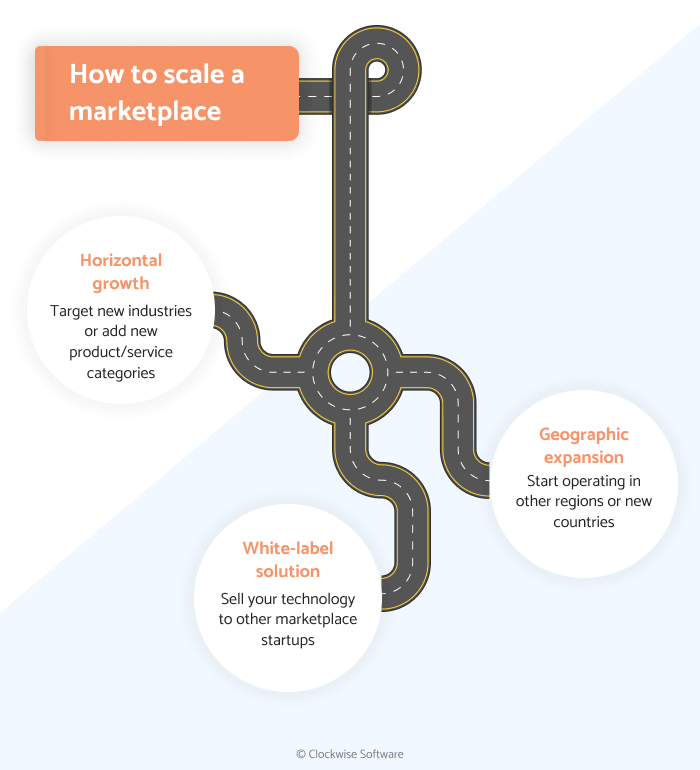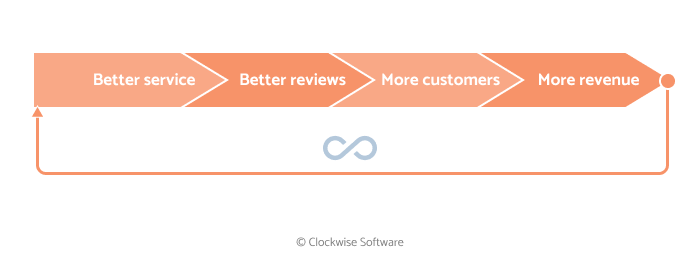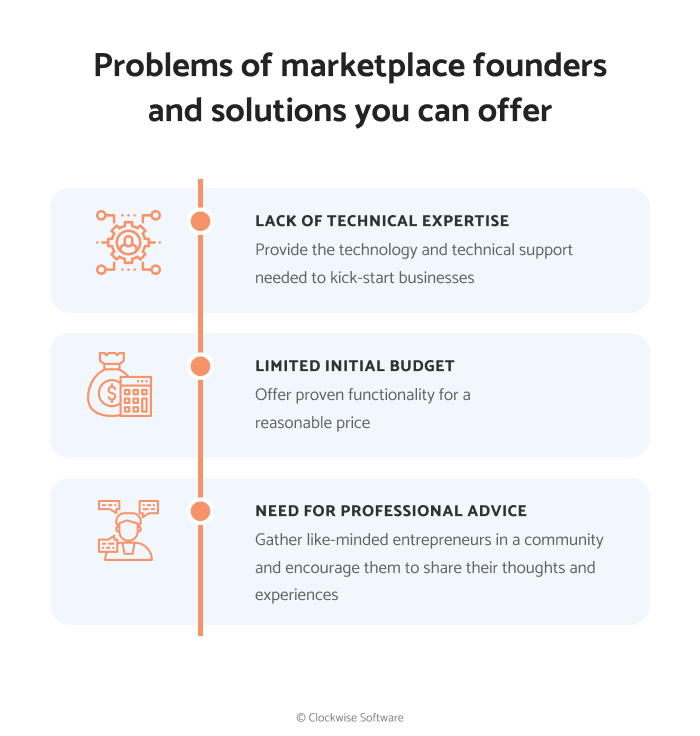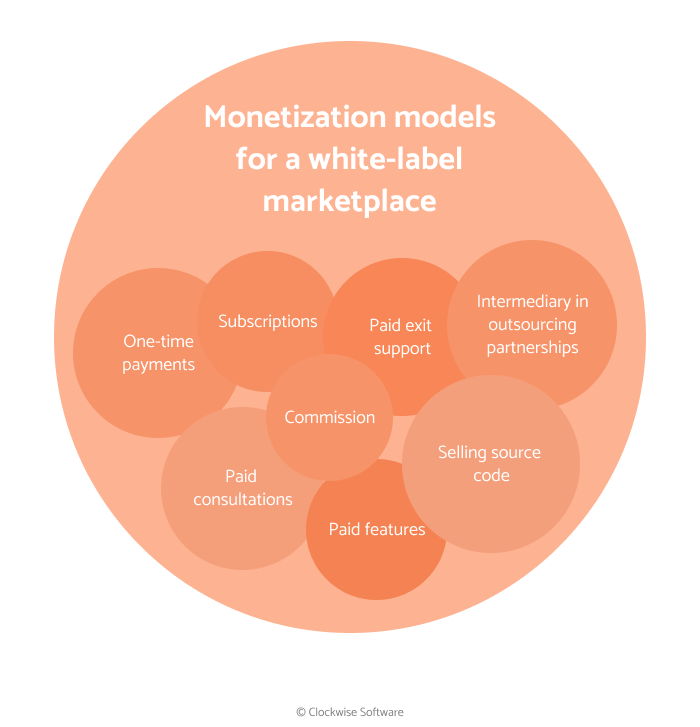What we do
Services
Experts in
Let’s assume you own an online marketplace. It attracts both sellers and buyers, and it generates some revenue. But it isn’t growing. You’ve reached a plateau, and you’re looking for an idea to scale your business and increase your revenue.
There are a few possible strategies:

In this article, we focus on a white-label marketplace service as an additional revenue source for your company and an alternative way to scale a multi-vendor business.
We’ll answer the following questions:
What exactly is a white-label online marketplace?
What technology is behind a white-label marketplace and what improvements does your system need to be offered as a white-label product?
What is the approximate time and cost of converting an existing marketplace into a white-label solution?
We also review the tough competition and nuances of providing a white-label platform.
You’re probably familiar with white-label grocery products. They work like this: Company X produces yogurt and sells it to retailers A, B, and C. The retailers give this yogurt their own branding and sell it in their own stores.
Retailers A, B, and C have their own brands, but they don’t own any means of production. They just cooperate with white-label companies, rebrand those companies’ products, and sell those products under their own brands.
Today, the white-label concept has entered the software market as well.
Let’s say company Y creates a pre-order app for the hospitality industry. Street food vendor A from New York, cafe B from Adelaide, and restaurant C from Singapore each purchase a license, rebrand the application, and provide pre-order services to their customers.
This business model can work with absolutely any type of application, including an online marketplace.
A white-label app is developed by one company and then sold to other companies for rebranding and their own use.
In the case of an online marketplace, you can sell your platform to other entrepreneurs who can customize it, rebrand it, and start their own businesses on top of your technology. But what are the benefits for you?
We know what you’re thinking about now: Why would I give away my technology and support my potential competitors?
At first sight, providing white-label software to entrepreneurs seems like creating competition to your initial marketplace business. But in fact, there’s nothing to fear.
For most companies, customer success is the main priority, and it directly impacts a white-label marketplace business as well. With a white-label product, however, successful customers tend to leave.
As we mentioned above, a white-label solution is commonly used to build an MVP, prove a concept, and raise money to build a full-featured custom product.
This means successful customers will leave you as soon as they have enough money to start developing a custom app. However, that’s not an excuse to deliver low-quality service and slow down customers’ growth. Whether your customer’s lifetime is two years or two months, you should strive to provide the best service possible.

Hundreds of marketplace ideas are born every day, and they all need to be tested. Your goal is to make your white-label product the number one option for such experiments so you ensure a stable flow of new customers and therefore revenue.
On the other hand, you can keep working with customers even after their businesses reach the limits of what your white-label app can offer. You can do this by offering paid membership in a marketplace owners community, providing technical consulting, or becoming the intermediary between your customers and a software development agency.
Think back to your first steps in the online marketplace industry. It definitely wasn’t a cakewalk. Today’s marketplace startup founders face the same problems you did.

Entrepreneurs have completely different reasons to choose a white label solution, but in most cases, they aim to test their startup idea with minimal time, money, and other resources. Naturally, many ideas will fail, and that’s completely okay. But the easier the testing process, the more people will dare to try.
A white-label B2B marketplace is a beneficial business. And since you already own a marketplace, you’re halfway there. In the next section, we discuss the steps needed to convert your existing online platform into a SaaS marketplace.
A white-label application is designed to be branded. So the first step in converting your traditional online marketplace software into a white-label product is adjusting the interface.
Your customers won’t agree to share the same design with dozens of other platforms. They’ll come with their own logos, corporate colors, and preferred fonts. Most likely, they’ll want a specific style for all buttons, and they won’t agree with your initial placement of elements. How can you satisfy them all?
Make your white-label app design customizable and flexible. Predict changes your customers might request and implement them in your design.
You can go deeper into this topic with a detailed article on UX Planet about design systems for white-label apps.
Additionally, you can check out a concept our team recently created for a white-label restaurant application.
Need a hand with making your marketplace design brandable and flexible? Share a link to your online platform and we’ll consult with you about the next steps.
Your new application has to become a new source of revenue for your business. So think carefully about how you’re going to monetize it. You have a few options:
Along with these classic monetization strategies, you can opt for some not so obvious ones:

There’s no perfect monetization model for an online white-label marketplace. However, a smart combination of these strategies may prove successful. Also, think out of the box and look for less obvious monetization strategies.
Multi-tenancy is the ability of a single app instance to serve multiple customers, or tenants. In a multi-tenant app, a single back end is responsible for the functionality of many apps. You can connect this back end to multiple front ends, or user interfaces. As a result, many applications that may look completely different can use the same server.
Multi-tenancy is at the heart of any white-label software. It enables you to create as many tenants as needed, customize their front ends, and connect them to the existing back end.
Choose your cloud service provider
Amazon Web Services (AWS) is the absolute leader in cloud services, covering 32.2% of the market. Its closest competitor, Microsoft Azure, has 17.6% of the market, and third place is occupied by Google Cloud with a 6% market share. You can find more 'rel="nofollow noopener" 'rel="nofollow noopener"cloud market statistics as of February 2020 on ParkMyCloud.
Our 'rel="dofollow noopener" 'rel="dofollow noopener" 'rel="dofollow noopener"comparison of top cloud services providers including AWS, Azure, Google Cloud, DigitalOcean, and Heroku will give you a better understanding of the available ecosystems.
These providers offer more or less the same services for comparable prices. We recommend opting for AWS because it offers a large ecosystem for multi-tenancy software. AWS Lambda is the central technology for creating a white-label architecture. It can be supported by AWS API Gateway, DynamoDB, AWS S3, AWS Cognito, AWS CloudFormation, AWS CloudFront, AWS Systems Manager, AWS Identity and Access Management, etc. Amazon offers a variety of services to match the needs of any white-label project.
Implementing multi-tenancy in an existing project is a task for a software architect with a proven background in cloud services.
The main responsibility of this architect is to learn the architecture of your project inside and out, decompose it, and divide it into functional components. Then every component should be rewritten to enable multi-tenancy.
As a result, all tenants will have custom front ends, databases reserved for their projects, and access to the shared marketplace back end.
Our team helped Whitelance - a freelancer marketplace - implement multi-tenancy, and the marketplace is now operating as a white-label service. Here, you can read the review on this cooperation our partner left on Clutch.
Let’s say a customer opts for white-label marketplace software because they don’t have the technical expertise needed to build a product from scratch. They also prefer to keep their distance from all technical matters and focus on their business.
How can you satisfy such a customer?
With a smooth and well-organized onboarding process. Here are the main components of such a process:
Starting to use your white-label marketplace application should be easy. So leave all the difficult technical stuff behind the scenes and provide user-friendly onboarding.
No two businesses are the same. When it comes to marketplaces, each has a specific goal, a unique background, and distinct needs. It’s not always possible to develop a business with a standard set of tools. Sometimes, specific functionality is needed, and in many cases, your customers will be ready to pay for it.
Think of possible scenarios and pricing for your on-demand development services. For example, you can set a fixed hourly rate for your technical team and charge customers depending on how much time you invest in creating the requested custom solution.
Note that providing on-demand services requires you to have a few developers on your team who are ready to take on tasks immediately. Alternatively, you can cooperate with a software development outsourcing company to hire the specialists you need only when there’s a job for them to do.
At this point, you have an online marketplace platform and want to make it a source of revenue for your company. How much will you need to invest?
At Clockwise Software, we’ve worked on similar projects, so we’ll provide numbers based on our experience.
First of all, let’s consider development time. Converting an online marketplace into a white-label service takes 2 to 3 months with one software architect on board.
The cost starts at $20,000.
Along with handling the actual programming, we can offer a discovery phase, business consulting, and design services. This means you can contact us with a raw idea and we’ll work with you to bring it to the market.
